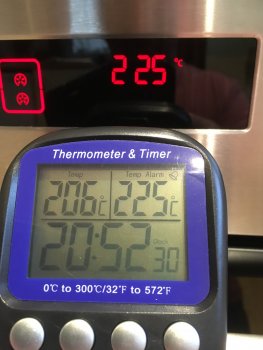The rate of quench will be determined by the alloying present. The more alloying, particularly things like Cr, and Mn, the slower the quench can be, eventually making air possible. Tempering absolutely should be done as soon as possible. If true full hardness is reached, immediate tempering is important. A larger kitchen oven will be superior to a toaster oven in heating for an even and accurate tempering . It is all about the thermal mass, something the size of a breadbox will spend all of its time overheating and underheating rather than holding the required steady temperature. Not to mention proximity to elements and amount of insulation.
Thanks for the reply Kevin and explaining about tempering.
With regards to the toaster oven, yes they are all over the place , over and under heating as I have exactly the same problem when I am curing my stabilised blocks in mine. I have taken readings with a digital thermometer probe and there was something like a 40 degree c variation over 30 minutes or so!
Earlier I was chatting to my father who is a retired electrician and he said its is due to the ovens being controlled by a simple cheap thermistor ?(think that's what he said ) and as you said no insulation.
I even built an external control unit using a variable resistor to control the power going in. This improved the situation slightly, around 5-10 degree variation but obviously still not what I wanted to achieve
What I am thinking of doing after doing a some reading up via searches is to rip apart my toaster oven, then remove, the temperature controls and thermistor. I will also shield the heating elements.
The oven will then be controlled via a new digital PID controller with a solid state relay and a dedicated temperature probe in the oven .The oven exterior will be insulated to keep the heat from escaping as much as possible. For thermal mass I will place a couple of inch thick fire bricks inside.
Hopefully it will work as my father tells me the PID controller is a type that controlled heated wrapping systems in the factory where he worked and is accurate to within 1 degree c. If it doesn't work it wont have cost me anything except for a temperature probe and a relay, both not expensive.
EDIT. I had several block to cure this eve and so tried two changes within the oven. Firstly I removed the cover from the bottom element (just a sheet that slides in and out) and put that so it covered the top element. Then I placed three fire bricks of around 10x4x1 over the bottom elelements and turned on the power. I was very surprised to find there was already a big difference in the heat up/ fluctuations as now the oven is heating up slowly as opposed to ridiculously fast before and the temperature climbing at a good slow rate, once it is up to temperature I will see how it holds but I have no doubt whatsoever that the firebricks have made the biggest difference here as the are very dense bricks for the base of my wood burning stove.
EDIT. Ok 40 mins later I checked the temperature, which was rising slowly but I turned the temp. down slightly and it seems to be holding at 114 which means by my reckoning the oven is out by 14 dec C...…..another 40 mins and it is holding at 103C so the bricks were retaining the heat....actually great for the stabilisation liquid I use so at least one result ))
I think I will check me main house oven later this week, which if ok is fine for steel but not the curing of the stabilising solution, did that once in the kitchen oven and never again lol.
Oh and I omitted to say Chris, I am going to buy the toasting oven with the biggest capacity I can find as the one I have now is tiny, that way I can get more volume.


